Recent Articles
Popular Makes
Body Types
Chrysler Imperial Concept First Drive
This luxury sedan concept proves Chrysler has what it takes to go upmarket
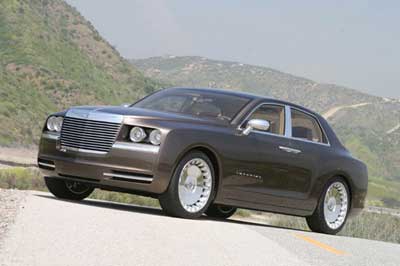
SAN BERNARDINO, Calif. – Chrysler took a huge gamble with the redesigned 300 sedan, proving in the end that consumers will pay a premium for an American car when the product is exactly right. What made the Chrysler 300 so popular was its upscale design, backed by credible performance and quality materials in a package that didn’t command a huge premium over look-alike workaday commuter sedans such as the Honda Accord and Toyota Camry. The 300 had style, it had class, it could carry five in comfort, and it had a Hemi under the hood. To alleviate concerns about its rear-drive powertrain and V8 fuel economy, Chrysler even offered all-wheel drive as an option and installed a Multi-Displacement System for the engine to improve highway efficiency. The result was an automobile that people aspired to own, one that was actually attainable on a middle-class income, one that knocked the socks off the media and the masses. Now Chrysler must decide if it can take that affordable, aspirational theme one step further, and the Imperial Concept is a bid to measure reaction from the public and the press. Introduced at the 2006 North American International Auto Show, the Imperial Concept rolled onto the stage with actress Eva Longoria riding in the spacious rear seat, adding a bit of star power to a vehicle already infused with presence. As with the 300 sedan, which unabashedly borrows styling cues from Bentley, Chrysler looked to British motorcar heritage as well as its own in creating the Imperial. The result looks much better in person than in pictures, especially when its lustrous Imperial Bronze paint is bathed in warm Southern California sunlight. Chrysler invited us to drive the Imperial Concept near San Bernardino, but this is not a driving impressions story. Concept cars might look terrific, but they drive like homemade kit cars. Chrysler reps asked us to keep speeds at 20 mph or less, and though the Imperial Concept has a stock 5.7-liter Hemi V8 under its long, V-shaped prow, the powertrain was locked in limp-home mode, the transmission running in our choice of first gear or reverse. The suspension rattled over the slightest bumps, and the dashboard was just for show – no operating gauges, no climate control, and only power front windows available to vent the interior, which suffocated under the Imperial’s bronze-tinted glass roof in the searing desert sun. We did learn a few things from the brief drive, however. First, if Chrysler produced the Imperial and sold it for $55,000, it would impart the look and feel of an automobile four times that price. The view over the long hood, the appearance of the retro-styled dash, the sheer size of the thing reminded us of a variety of classic Rolls-Royce models, from the Silver Cloud of the 1950s to today’s Phantom. The car has presence, it has heft, and in production trim it would exude luxury – all it needs is a big honkin’ hood ornament glittering in the sun. Based on our impressions of the Imperial, if Chrysler is wondering if it can compete in the luxury car class with something bigger and more opulent than the successful 300, the answer is yes.
Design Brief
Though we see plenty of Rolls-Royce influence in the Imperial Concept, Chrysler says it looked into its own back catalog for inspiration. Aiming to create a provocative luxury automobile, the company cites the Imperials of the 1930s, 1950s, and 1960s as models of elegance, as well as previous Chrysler concept cars such as the d’Elegance, Falcon, Chronos, and Firepower. Take the Imperial Concept’s grille, for example. Its horizontal bars resemble decorative elements found on the 1939 Custom Imperial Sedan, which carried up to seven passengers in stately splendor – not unlike a modern Cadillac Escalade, eh? Virgil Exner came to Chrysler in 1949 to head up the styling department, and he favored traditional design elements such as upright grilles, sleek profiles, and simple wheel openings – all of which are seen in the Imperial Concept. Exner’s vision dominated Chrysler design during the late 1950s and early 1960s, and the simple block lettering for the name “Imperial” and the floating headlamp housings under a heavily lidded brow are two elements of the concept that appear to be derived from this era (late 1950s and early 1960s, respectively). Don’t tell Chrysler, but we even see a little bit of the 1982 Chrysler Imperial Frank Sinatra Edition in this new concept car, in the LED strips under the front and rear lights and the bustle-back trunk. Unfortunately, many Imperials of the past were hideous tanks. Wisely then, though Chrysler doesn’t admit it, the corporate heritage cues have been grafted onto shapes more British than American. There’s no mistaking the Imperial Concept’s front and rear fender lines for anything but vintage Rolls-Royce, and the roofline and greenhouse echo a long history of Rollers from the 1950s to today’s Phantom. It’s in these general forms, and not the Imperial’s details, where success could lie if Chrysler decides to build this car. The 300 sedan is a hit, in part, because it looks like a knock-off Bentley. Imagine how Americans would flock to showrooms to get their hands on a Rolls-Royce Phantom at an 80-percent discount. All Chrysler needs to seal the deal is fake Louis Vuitton upholstery, and these things would fly out of showrooms.
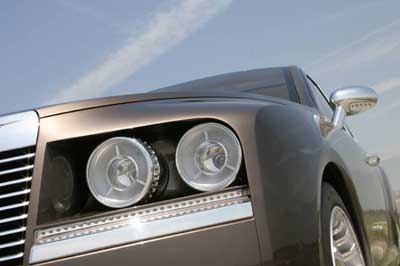
Exterior Design
Say what you will about the Chrysler Imperial Concept’s exterior design: we have. In fact, we named it one of the Top 10 Duds from the auto show circuit this year, but that was before we saw it on the road in natural light. The car looks better up close and in person, though it’s not quite a beautiful piece of machinery. This polarizing appearance is by design, since creative types usually want the fruit of their labor to grab attention and spark controversy. Since the company claims plenty of elements were cribbed from a variety of downright ugly Imperials of the past, getting the desired impact was probably pretty easy. Mike Nicholas was the Chrysler Imperial Concept’s principal exterior designer, and he said stylists wanted the car to blend “stately nobility, hand craftsmanship, and a modern dynamic sculpture and proportion.” His team started with the same platform that serves as the basis of the 300 sedan, stretching the wheelbase 3.3 inches. Not surprisingly, then, the Imperial Concept is longer than a 300, adding 17 inches stem to stern, as well as six inches of height. Sitting on its chrome 22-inch wheels, the Imperial Concept is imposing, about the size of a Rolls-Royce Phantom in height and width, but stubbier by more than a foot. The Chrysler Imperial Concept’s body is hand-sculpted, like custom coach-built LeBaron bodies of yesteryear (no, not like the highly collectible, era-defining 1988 Chrysler LeBaron Turbo Town & Country station wagon, smart guy). The Imperial’s blunt visage is dominated by a bold V-shaped power dome hood and an audacious grille flanked by distinctive headlamps. Chrysler says the Imperial’s upright radiator grille “impart(s) a stately eminence previously unattainable in all but the most expensive of motorcars.” Well, except for clapped-out Cadillacs wearing an aftermarket E&G “Classic” monstrosity of a grille. Crafted of polished and brushed aluminum, and capped with Chrysler wings and logo, the Imperial’s grille fronts a bright spear of molding that stretches the length of the hood to the base of the windshield. Round headlights mimic the freestanding units on Imperials of the 1930s and early 1960s. Nestled under a heavy brow, the polished aluminum parabolic pods house modern projector beam lamps. A sweeping character line arcs from the lower front air dam over the front wheels to the door handles, blending into the Imperial’s body in front of similarly flared haunches designed to communicate that this is a powerful, rear-drive vehicle. Brightwork is limited to the door handles, the dished 22-inch wheels, the side mirrors, the window surrounds, and the “Imperial” script on the lower portion of the front doors. At the Chrysler Imperial Concept’s rear, individual circular taillights with floating outer rings are styled to resemble the “gun sight” lights common on previous Imperials. These, however, contain LED lighting units, underlined by separate thin LED lamps which handle signaling and reverse functions. Designers achieved impressive symmetry with the Imperial’s front end thanks to a raised trunk lid, similarly shaped lighting elements, an identically sized Chrysler badge, and a license plate recess that ties in with the body-colored center panel between the taillights to mimic the proportions of the grille.
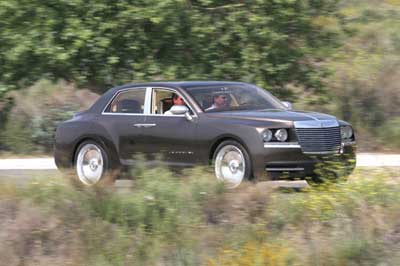
Interior Design
Nick Malachowski is a hero. He led the team that designed the Chrysler Imperial Concept’s interior, a gorgeous, simple, luxurious space where four adults sit seven inches higher than they would in a 300. Malachowski said stylists “wanted everything inside to be nested, fitted, and handcrafted, with every component subtly reinforcing the hand-sculpted look of the exterior.” Passengers enter the Imperial Concept through doors hinged at the A- and C-pillars. Historically, these have been called “suicide” doors, and according to Wikipedia, the current authority on any subject on the planet, this name was coined because of a fear that if the doors became unlatched while the car was underway, or if passing traffic clipped the door while a passenger was exiting, the potential for harm to occupants was greater than with a conventional layout. Today, these are called “reverse-hinged” doors, or “access panels,” and can be found on vehicles ranging from the Honda Element to the Rolls-Royce Phantom. Imperial occupants settle into one of four bucket seats covered in leather and suede, facing a beautiful retro-themed dashboard. Dressed in two-tone Bay Brown and Birch Crème décor, the Imperial employs California burl wood, metallic accents, and LED accent lighting to create an upscale environment. Stylists wanted the Imperial’s major elements to appear as though they float, so the seat mounting hardware is hidden, the door panels employ recessed sculptural elements, and the massive dashboard appears to hover. Chrysler calls this a driver’s car, with a minimum of distracting gadgets inside. Twin circular gauges rendered in satin finish with polished aluminum bezels and aqua backgrounds with black lettering house displays for speed, revs, and fuel level. Designed to recall earlier Imperial models, the gauges are like fine timepieces from another era. Minimalist controls for the stereo, climate system, and navigation functions are clustered on the center of the dash, above a gated gear selector with Chrysler’s AutoStick manual shifting feature. The steering wheel’s center pad includes stereo and cruise controls, and it remains stationary when the rim is turned, but this feature is unlikely to ever reach production – we were warned to watch our fingers lest they get pinched. Rear seat passengers benefit from plenty of head and leg room, sitting on multi-adjustable bucket seats separated by a decadent center console and control panel. The rear seats can recline, and passengers can watch different movies on the console-mounted dual-view entertainment screen and individual headsets.
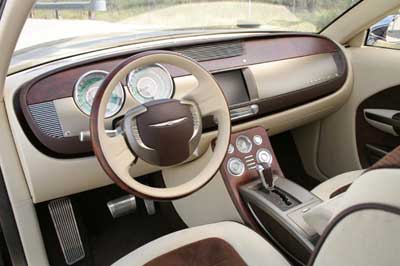
Nuts and Bolts
Underneath the Chrysler Imperial Concept lives a modified 300C sedan. Powered by the seemingly ubiquitous 5.7-liter Hemi V8, the Imperial is rated to make 340 horsepower and 390 lb.-ft. of torque. Power flows to the rear wheels through a five-speed automatic transmission, but a production version of this car would certainly upgrade to the seven-speed automatic sitting in the DaimlerChrysler parts box to avoid negative press. Despite its certain obesity on the scales, Chrysler says the Imperial Concept could theoretically accelerate to 60 mph in 5.5 seconds and achieve a top speed of 160 mph, which is like saying that I could theoretically land a smoking hot date with Jessica Alba after completing the Ironman triathlon in record time. We doubt this car would be able to make those numbers with the Street and Racing Technology team’s fire-breathing 425-horse 6.1-liter engine, let alone this 5.7-liter unit, but then we were English majors and not engineers. One thing is for sure, though. We doubt many Imperial buyers would want to swap out the gorgeous double-dubs wearing P245/45R22 tires. Damn baby, those rims are fly. They’re hooked to a four-wheel-independent suspension, short- and long-arm up front with a five-link arrangement in the back. Brake specifications weren’t provided by Chrysler, so we’d guess the Imperial would get binders at least as stout as those on the 300 SRT-8, and that this luxury sedan would benefit from standard brake assist and stability control systems. What’s the real viability of a Chrysler Imperial? Since most of the hardware is off the shelf, and with the recent debut of the 300 Long Wheelbase, it’s not inconceivable that the Imperial could land in showrooms as a budget ultra-luxury sedan in the mid-$50,000 range. If Chrysler can crack the livery business and steal sales from Cadillac and Lincoln on that front; supply enough quality, style, and performance to sway all 25 buyers of the Acura RL and Infiniti Q45; and inject enough performance and prestige to make BMW and Benz buyers do a double-take; the Imperial’s business case should be a solid one. At the very least, this car should replace the aged Lincoln Town Car as the airport shuttle of choice, don’t you think?
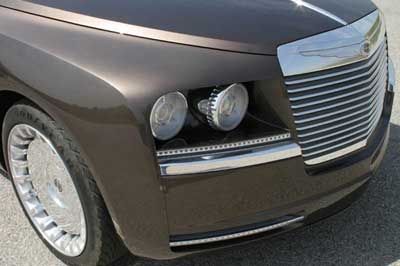
Specifications
Test Vehicle: Chrysler Imperial Concept Price of Test Vehicle: Like an experience charged to your MasterCard, priceless Engine Size and Type: 5.7-liter V8 Engine Horsepower: 340 horsepower Engine Torque: 390 lb.-ft. of torque Transmission: Five-speed automatic with AutoStick manual shift feature Observed Fuel Economy: Better than a Freightliner, worse than a Prius Length: 214.1 inches Width: 76.1 inches Wheelbase: 122.9 inches Height: 63.6 inches Max. Seating Capacity: Four Competitors: Audi A8, BMW 7 Series, Cadillac DTS, Infiniti Q45, Jaguar XJ, Kia Amanti (ha!), Lexus LS, Lincoln Town Car, Mercedes-Benz S-Class
Photos by Ron Perry
